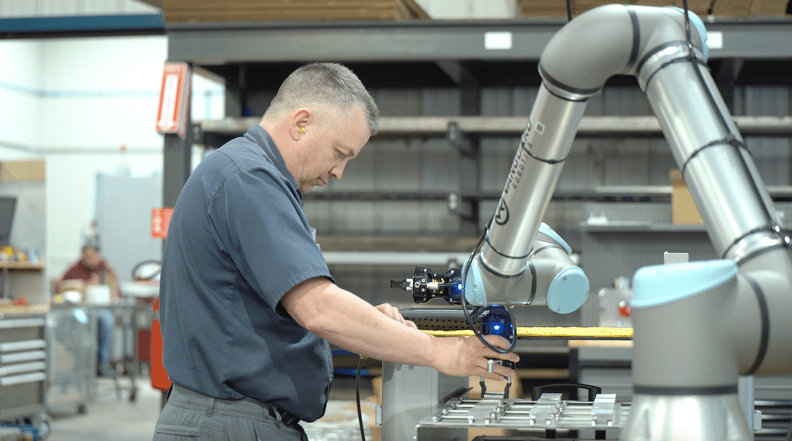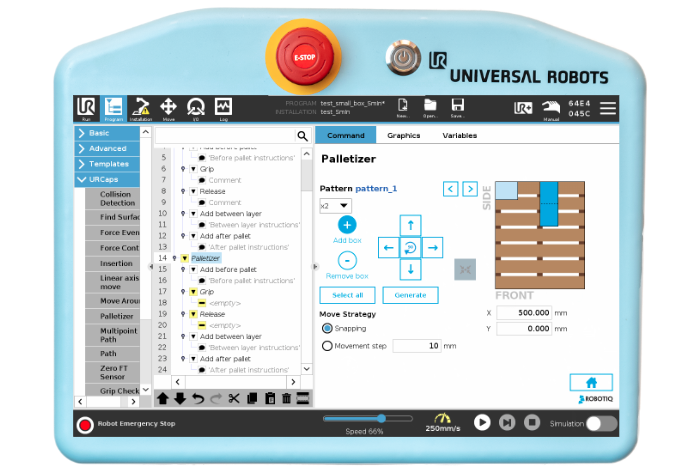15 Types of CNC Machines and How to Automate Them

Posted on Nov 08, 2022 in Automation
6 min read time
CNC machines are a staple in many factories and workshops. They are a core technology for creating precision parts and products.
Automating a CNC machine can help you improve its productivity and machine utilization, while freeing up your operators for more complex, rewarding tasks. It reduces the need for human operators to be standing over the machine for many hours simply to load and unload the machine.
There are many types of CNC machines. You might use one or more of them in your own manufacturing processes. Each machine has its own unique function and purpose. Some are easier to automate than others, but all can benefit from added automation in the right circumstances.
In this article, you will learn how you can automate various CNC machines using robotic automation.

The similarities between most CNC machines
At their core, most CNC machines comprise the same basic components. For this reason, automating almost any type of CNC machines involves a similar process.
These common components are:
-
The enclosure — This houses the rest of the CNC machine components, apart from the controller, which is usually mounted on the outside. A manual or semi-automatic door is used to access the inside of the machine.
-
The machine bed — This is the foundation of the machine on which all other components are mounted. It supports the weight of the other components and the workpiece being machined.
-
The work head — This holds and moves the tool. Depending on the type of CNC machine, it can move in various directions.
-
The tool — This is the "business end" of the CNC machine — it performs the cutting, shaping, or other process task on the workpiece. It is mounted to the end of the work head and can be changed to suit the task.
-
The controller — This houses the electronics and software that controls the machine. You can program it using a computer or directly through the controller screen.
Any automation solution will need to interface in some way with these components. Usually, the robot's controller will interface with the controller electronically. The robot will place workpieces onto the machine bed.
How to automate almost any CNC machine with a robot
You can automate almost any CNC machine with a robot, though some are easier to integrate with an automation solution than others.
The easiest way to automate a CNC machine is with a robotic application kit for machine tending. This will include all the hardware and software elements that you will need to automate your machine with a robot.
Robotiq Machine Tending Solution uses an ingenious method of machine communication to allow it to easily integrate with almost any CNC lathe or milling machine — it uses the same buttons, lights, and switches that a human operator uses to interact with the machine. This significantly reduces the integration work required compared to more conventional solutions.
The steps to integrate almost any CNC machine with a robot are:
-
Choose the type of CNC machine you want to automate.
-
Use the Robotiq Machine Tending Configurator to configure your specific application kit (or get in touch if your machine type isn't listed in the configurator).
-
Install the kit and configure the software using the simple Machine Tending Wizard on the screen.
-
Deploy the robot in your production line.
-
Monitor the results and use your learnings to deploy your next CNC machine tending robot.
15 types of CNC machines you can automate with a robot
There are many CNC machines available. Some, like lathes and milling machines, will work out of the box with an application kit. Others might require more custom automation.
Here are 15 common types of CNC machine:
-
Lathe — This is used to create precise, symmetrical parts and products from a variety of materials including metals, plastics, and wood.
-
Milling machine — This cuts and shapes materials using a rotating cutting tool. It’s commonly used to create intricate designs and shapes for a variety of applications.
-
Router — A router is like a milling machine but it’s typically smaller. It’s used to cut and shape wood, plastic, and metal. It is used for applications like engraving or carving signs.
-
Plasma cutter — This uses a high-velocity stream of hot plasma to cut through metal, for applications like industrial construction, restoration, and salvage operations.
-
Laser cutter — A laser cutter uses a concentrated beam of light to cut through material. Common applications include the creation of signs and decorative engraving.
-
Waterjet cutter — This uses a high-pressure stream of water to cut through materials. Applications include cutting of stones, tiles, glass, and metal.
-
Oxy-fuel cutter — This uses a combination of oxygen and fuel to cut through metal. One common application is the creation of plate edges for groove and bevel welding.
-
Punch press — This uses a die to cut or shape material. Common uses include the creation of countersinks, embossments, extrusions, and louvres.
-
Bending machine — This is used to bend or fold sheet metal. Applications include bending of brackets, clamps, and product covers.
-
Shearing machine — This cuts sheet metal using blades. Application areas include the automotive and aerospace industries.
-
Press brake — This bends or folds sheet metal using a die. Such machines are often used in marine engineering, metal artwork production, and furniture manufacture.
-
Turret press — This is a type of punch press that has a rotating turret that holds the dies. Common uses include the creation of stamped features such as louvers, card guides, lances, electrical knockouts, and dimples.
-
Hydraulic press — This uses hydraulic fluid to apply force to an object. Commonly used in a host of application areas, including transportation, energy, and transportation.
-
Electric discharge machine — This uses electrical pulses to cut through metal. Common uses include mold and die making, small hole drilling, and medical component manufacture.
-
Grinding machine — This grinds or polishes surfaces. Commonly used for general machining tasks and automotive part manufacturing.
These are just some of the most common types of CNC machines. There are many others that are used for specific tasks and industries.
.jpg?width=820&height=460&name=Hugo+3cobots%20(4).jpg)
How to Automate Your Specific CNC Machine
It doesn't matter what type of CNC you have, you can almost certainly automate it in some way.
If you are using a common CNC machine, like a lathe or milling machine, you can use a solution like the Robotiq Machine Tending Solution straight out of the box.
For other types of machine, get in touch and we can help you out.
What type of machine would you like to automate? Tell us in the comments below or join the discussion on LinkedIn, Twitter, Facebook, or the DoF professional robotics community.








Leave a comment